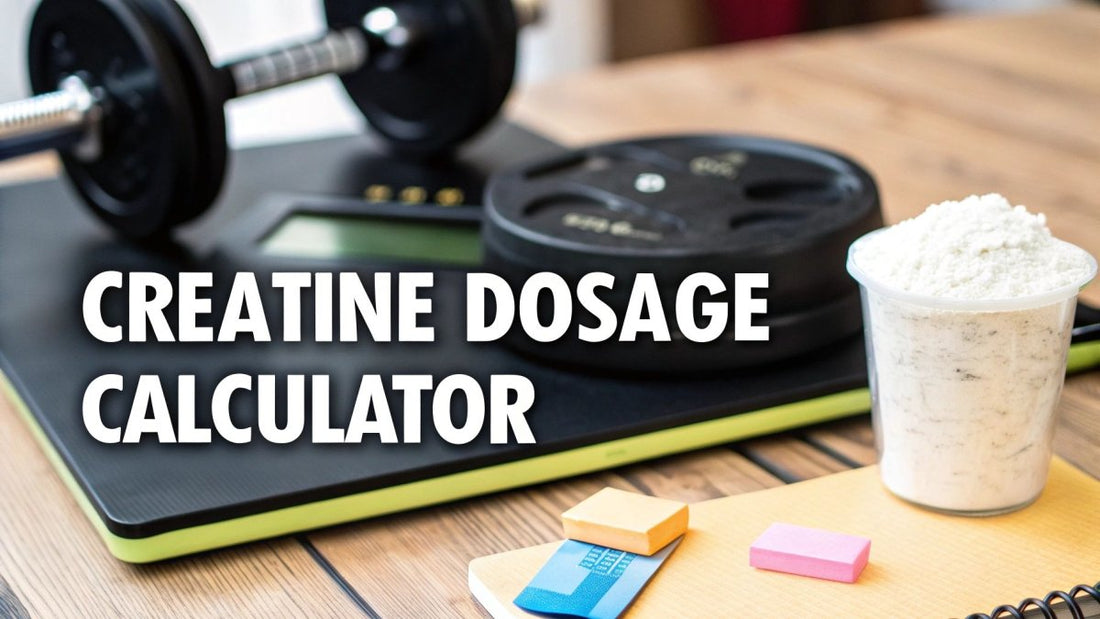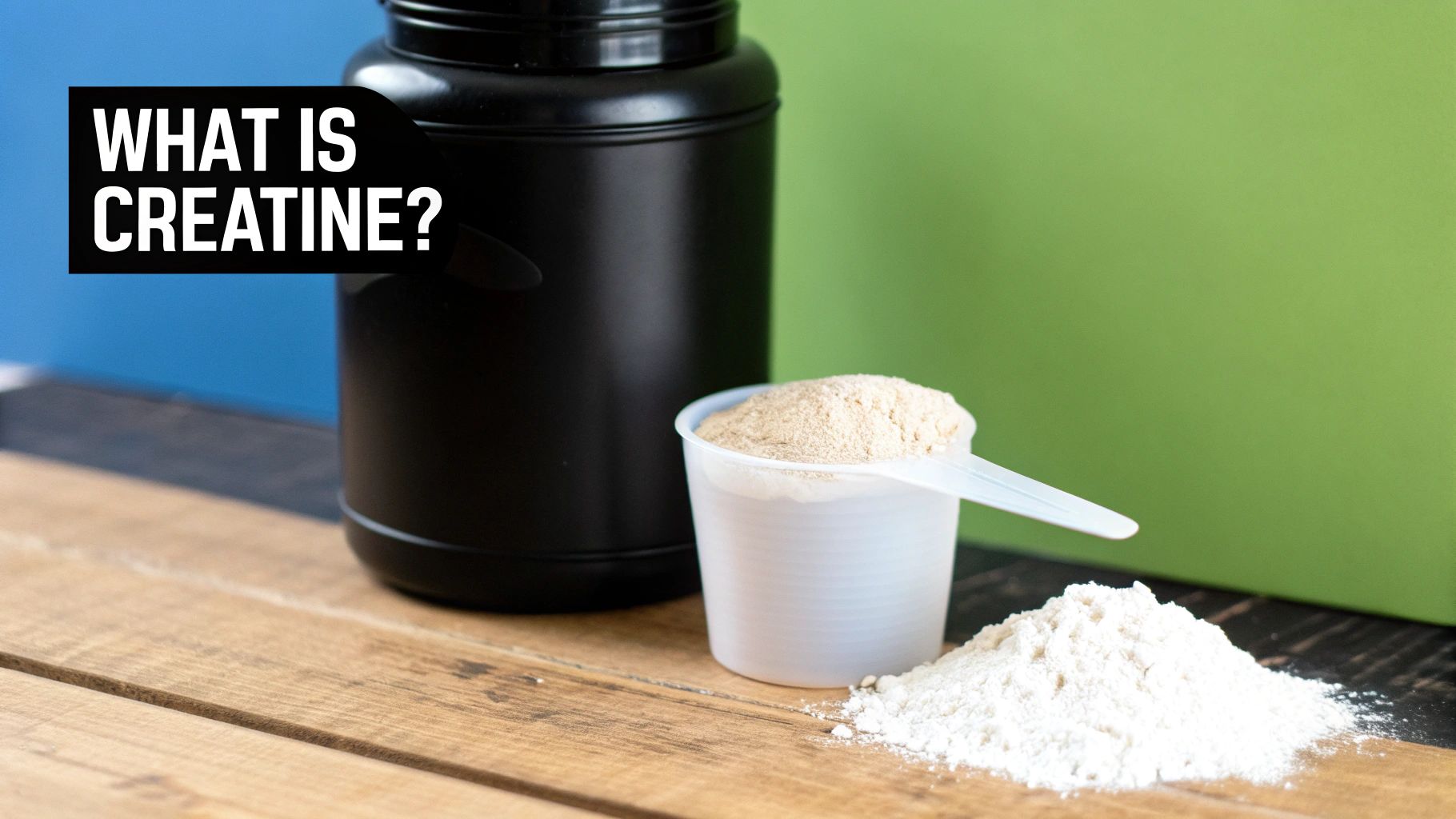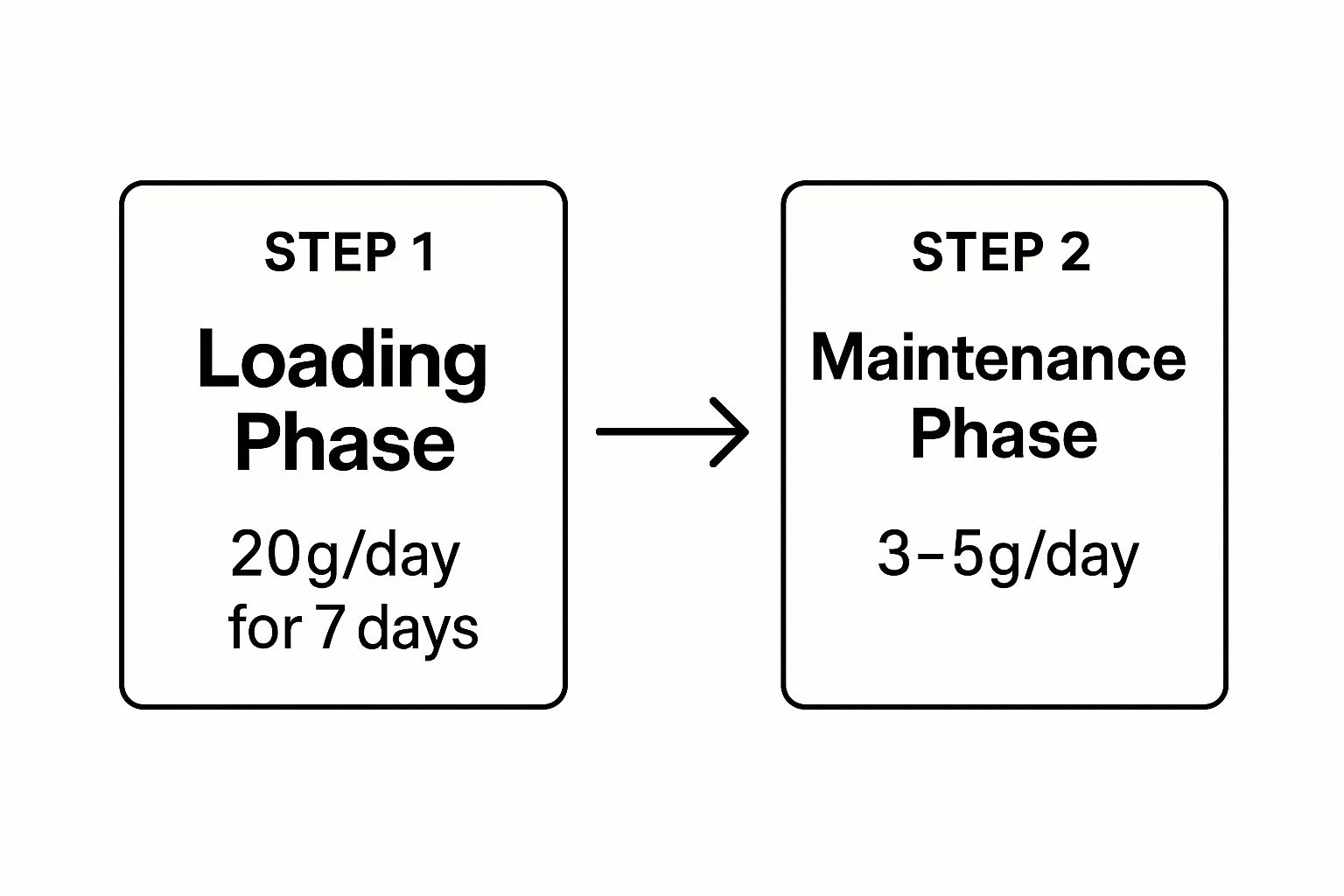
Your Perfect Creatine Dosage Calculator
Share
You’ve probably heard the standard advice: take 5 grams of creatine a day. It's not bad advice, but it's a bit like a one-size-fits-all t-shirt—it works, but it's far from a perfect fit. The truth is, the single most important factor in your creatine dosage is you. A dose calculated for your specific body weight will always be more effective, helping you saturate your muscles properly and get the results you're after.
Why Your Creatine Dose Should Be Personalized

Let's move past the generic recommendations and get into what actually works. Think about it logically: a 220-pound powerlifter has way more muscle mass to fill up with creatine than a 140-pound endurance runner. Handing them both the same 5-gram scoop just doesn't add up from a physiological standpoint.
The whole point of taking creatine is to top off your muscles' creatine phosphate stores. Your muscle mass determines how big that "gas tank" is. A personalized approach, usually based on your body weight, ensures you're putting in just enough to fill the tank without anything spilling over.
Tailoring Your Dose for Maximum Impact
Why bother with the math? Because this tailored approach is all about efficiency and better results. When you calculate a dose specific to your body, you set yourself up for faster and more reliable muscle saturation.
Here's what you get with a personalized dose:
- Faster Muscle Saturation: You get your muscles fully loaded with creatine sooner, which means you start feeling those performance benefits more quickly.
- Optimized Performance: Once your stores are full, you’ll see real, noticeable improvements in strength, power, and your ability to squeeze out those extra reps.
- Reduced Waste: Your body can't store extra creatine, so anything it doesn't need is just flushed out. A calculated dose means less waste and a better return on your supplement investment.
To really dial in your creatine intake, it helps to have a solid grasp on your body's metrics. A deeper dive into understanding your body composition can provide the context you need to optimize your entire fitness and supplement strategy.
The Science Behind Individual Dosing
This idea of personalizing supplements isn’t just a new trend. The science goes way back. In 1912, Harvard University researchers discovered that ingesting creatine could dramatically increase its concentration in muscle tissue. This proved that we could actually boost our natural stores. A decade later, studies in the 1920s confirmed the body could hold onto this supplemental creatine, which paved the way for the dosing strategies we use today.
The goal isn't just to take creatine; it's to use it strategically. Too little, and you might not fully saturate your muscles, leaving gains on the table. Too much, and you won't get any extra benefits—just a lighter wallet and maybe some stomach upset.
At the end of the day, using a formula based on your body weight is the smartest, most scientific way to go. It takes the guesswork out of the equation and aligns what you're taking with what your body actually needs to perform at its peak. For a complete look at different strategies, check out our comprehensive creatine dosage guide from beginner to expert results.
Calculating Your Creatine Loading Phase Dose
Alright, let's get down to the nitty-gritty: figuring out exactly how much creatine you should take during your loading phase. This is the initial five to seven-day period where the goal is to quickly top off your muscles' creatine stores. Getting this right from the start means you'll see those performance benefits a lot sooner.
Forget the generic "one scoop" advice. We're going to use a precise, weight-based formula that’s been the gold standard in research for years.
The most proven formula for a creatine loading phase is 0.3 grams of creatine per kilogram of your body weight, taken daily. This simple calculation takes the guesswork out of it and ensures your dose is matched to your body, not some hypothetical average person.
First, Convert Pounds to Kilograms
Most of us in the U.S. track our weight in pounds, so we need to do a quick conversion to kilograms to use the formula correctly. It's easy.
Just divide your weight in pounds by 2.205.
- The Math: Your Weight in lbs / 2.205 = Your Weight in kg
So, if you're a 150 lb athlete, your calculation is 150 / 2.205 = 68.03 kg. If you're a bigger lifter at 220 lbs, you'd be 220 / 2.205 = 99.77 kg. This single step is the key to personalizing your dose.
Putting It All Together: Your Daily Loading Dose
Once you have your weight in kilograms, the final step is a breeze. Multiply that number by 0.3 grams to find your total daily creatine intake for the loading phase.
- The Formula: Your Weight in kg x 0.3 g = Total Daily Loading Dose
Let’s see how this plays out for our two different athletes. The difference is pretty eye-opening.
Scenario 1: The 150 lb Lifter (68.03 kg)
- 68.03 kg x 0.3 g = 20.4 grams of creatine per day
Scenario 2: The 220 lb Lifter (99.77 kg)
- 99.77 kg x 0.3 g = 29.9 grams of creatine per day
Look at that—the heavier individual needs almost 10 extra grams per day to get the same muscle saturation effect! This is exactly why a one-size-fits-all approach doesn't work and why running the numbers for yourself is so important.
This infographic breaks down the two-step process, starting with the loading phase we're talking about now.

As you can see, it’s all about a short, high-dose loading period followed by a smaller maintenance dose to keep those levels topped off.
Why This Method Just Works
The 0.3 g/kg formula isn't just something someone pulled out of thin air; it’s backed by a mountain of scientific evidence. The whole point is to elevate your muscle creatine content to its peak as fast as possible.
A loading protocol of around 20 grams per day for five days has been consistently shown to boost muscle creatine stores by about 20%. This rapid increase is the catalyst for seeing quicker results in the gym, whether that's more power on your lifts or better endurance for those grueling sets.
This approach has been proven safe and effective for everyone from elite athletes to older adults trying to preserve muscle. In fact, you can learn more about the extensive research that has confirmed the safety of creatine monohydrate over the last 25 years.
Sample Creatine Loading Phase Dosages by Body Weight
To make things even easier, here’s a quick-reference chart. We've done the math for you based on the 0.3 g/kg formula for a few common body weights.
| Body Weight (lbs) | Body Weight (kg) | Total Daily Loading Dose (grams) | Suggested Serving (4x per day) |
|---|---|---|---|
| 140 | 63.5 | 19.1 g | ~4.8 g |
| 160 | 72.6 | 21.8 g | ~5.4 g |
| 180 | 81.6 | 24.5 g | ~6.1 g |
| 200 | 90.7 | 27.2 g | ~6.8 g |
| 220 | 99.8 | 29.9 g | ~7.5 g |
This table gives you a solid starting point for finding your ideal daily total and how to break it down into manageable servings.
Practical Tips for a Smooth Loading Phase
Trying to chug 20-30 grams of creatine in one go is a bad idea. Trust me. Creatine draws water into your gut, and a massive single dose can leave you feeling bloated or cramped.
The fix is simple: split up your dose.
Divide your total daily amount into four smaller, equal servings throughout the day. This is far easier on your stomach and helps your body absorb it better.
- Morning: Have the first serving with breakfast.
- Midday: Take the second with your lunch.
- Afternoon: Take the third, maybe an hour before your workout.
- Evening: Have the last serving with your dinner.
Our 150 lb lifter needing 20.4 grams would take four servings of about 5.1 grams each. The 220 lb lifter needing 29.9 grams would aim for four servings of around 7.5 grams. Pro tip: mixing each dose with some carbs can enhance absorption, as the insulin response helps drive creatine into your muscles. This simple strategy makes the loading phase both comfortable and highly effective.
Finding Your Daily Maintenance Dose

So, you've made it through the loading phase. Congratulations! Your muscles are now fully saturated with creatine, and the heavy lifting (pun intended) is over. The goal now is much simpler: keep those creatine stores topped off.
This next stage is the long-term maintenance phase. It doesn't require those high initial doses. Instead, you'll shift to a smaller, consistent daily amount to maintain those performance benefits you worked to achieve.
The Maintenance Dose Formula
The standard, scientifically-backed formula for your daily maintenance dose is 0.04 grams of creatine per kilogram of your body weight.
This isn't just a random number; it's calculated to be just enough to replace the creatine your body naturally uses and breaks down each day. This keeps your muscle stores full without overloading your system. And while we're on the topic of smart nutrition, it's just as crucial to determine your optimal daily protein intake to support all that hard work in the gym.
Let's check back in with our two athletes to see how their dosage changes for this long-term phase:
- 150 lb Lifter (68.03 kg): 68.03 kg x 0.04 g = 2.7 grams per day
- 220 lb Lifter (99.77 kg): 99.77 kg x 0.04 g = 4.0 grams per day
As you can see, the daily commitment becomes much more manageable, usually landing in that well-known 3-5 gram range for most people. This method is far more precise than the old-school "one scoop for everyone" approach.
The No-Load Alternative
What if the idea of a loading phase just doesn't sit right with you? Maybe you're worried about potential stomach issues or just prefer a simpler routine. Good news—you can skip it entirely.
The alternative is incredibly straightforward: just start with your maintenance dose from day one. For most people, this means taking 3-5 grams of creatine daily right from the get-go. This approach is simpler, gentler on the stomach, and gets you to the exact same place in the end.
So, what's the catch?
It just takes longer. A loading phase gets you to full muscle saturation in about a week. Starting with a maintenance dose will take roughly three to four weeks to achieve the same result.
There's no single "right" way to do it. The best method is the one that fits your body and your lifestyle.
Consider Loading If:
- You want to see performance benefits as fast as possible.
- You have an event or competition coming up soon.
- You don't mind the slightly more complex routine for a week.
Consider Skipping the Load If:
- You value simplicity and an easy-to-follow plan.
- You have a sensitive stomach and want to avoid any potential discomfort.
- You're playing the long game and aren't in a rush for immediate results.
Ultimately, both paths lead to the same destination. The real key to creatine's success isn't how you start, but that you stick with it consistently. The timing of your dose also plays a part, which you can learn more about in our guide on when to take creatine for best results. Whichever approach you choose, a personalized maintenance dose is your ticket to sustained gains in strength, power, and performance.
When to Adjust Your Creatine Intake

So you've run the numbers, found your daily dose, and settled into a routine. It’s easy to think your work is done. You have your magic number, so you just take it every day, right? For the most part, yes. Consistency is the name of the game with creatine.
But your fitness journey isn't static, and neither is your body. Certain situations and goals might call for a second look at your daily dose. Thinking of your creatine intake as a fixed number forever is a missed opportunity to really dial in your results.
Higher Doses for Elite Athletes
The standard maintenance formula of 0.04 g/kg is a fantastic starting point for the vast majority of people. But what happens when your training volume is anything but standard? Elite athletes, competitive bodybuilders, or anyone with an exceptionally demanding training schedule might actually benefit from a slightly higher maintenance dose.
Think about it: these individuals are breaking down muscle tissue and torching energy stores at a much faster rate. Their bodies' demand for ATP regeneration is constant and intense.
For this highly active group, a maintenance dose closer to 5-10 grams per day—regardless of body weight—might be necessary to keep those muscle creatine stores completely topped off. This isn't a license for everyone to start doubling their dose, but rather a specific tweak for those pushing their physical limits day in and day out.
Creatine Use During a Cutting Phase
One of the most common questions I hear is whether to keep taking creatine when cutting calories to lose fat. The concern usually comes down to water retention. Creatine pulls water into your muscle cells, which can nudge the scale up and, mentally, feel like it's masking your fat loss progress.
Here’s the reality: this is intramuscular water, not the subcutaneous "puffiness" you might be fearing. In fact, this cellular hydration is a good thing—it keeps your muscles looking full and supports your performance in the gym.
Key Takeaway: Stopping creatine during a cut is often a mistake. The strength and performance benefits are arguably even more valuable when you're in a calorie deficit. It helps you preserve hard-earned muscle and keep your training intensity from tanking.
If the number on the scale is playing games with your head, just ignore it for the first week or two after starting creatine. Focus on the real metrics: how your clothes fit, your performance on your lifts, and what you see in the mirror.
The Great Creatine Cycling Debate
You’ve probably heard someone at the gym mention they're "cycling off" creatine. This idea comes from older theories that your body might stop producing its own creatine or that its receptors would become less sensitive if you supplemented all the time.
Modern science has pretty much put this idea to rest. Unlike some other supplements, there's no evidence suggesting your body's natural creatine production is permanently harmed by long-term use. Your muscles don't just "get used to it" in a way that makes it less effective.
So, is cycling necessary? For most people, the answer is a clear no.
Consistent, daily intake is the most effective strategy for keeping your muscle stores saturated and reaping those ongoing benefits. Taking breaks just lets your creatine levels drop, forcing you to go through another loading or saturation period to get them back up. This can take several weeks, which you can learn more about by reading our guide on how long it takes to see results from creatine.
When might a break make sense?
- Personal Preference: Sometimes you just want a break from taking supplements. That’s a perfectly valid reason.
- Extended Time Off: If you know you'll be away from the gym for a month or more due to a long vacation or an injury, you could pause your intake since you won't be training.
Ultimately, your creatine dosage is a dynamic tool. While your initial calculation provides a fantastic baseline, staying tuned in to your training intensity, body composition goals, and personal response allows you to make smart adjustments for optimal results over the long haul.
Common Creatine Dosing Mistakes to Avoid
Figuring out your ideal creatine dose is a great first step, but even the perfect number can fall flat if you trip over a few common hurdles. It's surprisingly easy to sabotage your own efforts. These slip-ups can water down your results, slow your progress, or just make you feel crummy for no good reason.
Let's walk through the most common pitfalls I've seen over the years and, more importantly, how to sidestep them. Getting this part right means every gram you take is actually doing its job.
Inconsistent Dosing and Skipping Days
This is hands-down the biggest mistake people make. It often starts after the loading phase. You're super diligent for that first week, then you switch to maintenance and get a little… relaxed. You miss a day here, another there, figuring it won't matter.
But consistency is everything with creatine. The entire point is to keep your muscle stores topped off and saturated. When you start skipping days, those levels slowly begin to drop. It’s not an overnight crash, but after a week or two of hit-or-miss dosing, you start to lose the very edge you were working to build.
- The Fix: Make it a non-negotiable daily habit. Set a phone reminder or, my personal favorite, "habit stack" it. Put your creatine tub right next to your coffee maker, your toothbrush, or your protein powder—something you already use every single day. Remember, rest days are just as crucial as training days for keeping those muscles saturated.
Forgetting About Hydration
Here’s the deal with creatine: it works by pulling more water into your muscle cells. This process, called cellular hydration, is a huge part of what makes it so effective. It gives you that "full" muscle look and helps create a better environment for growth.
But that whole process hinges on one thing: you have to give it water to work with. If you're not drinking enough, you’re not just short-changing your results—you’re also asking for trouble in the form of mild dehydration or cramping.
Pro Tip: Don't wait until you're thirsty to drink. Thirst is a sign you're already behind. Get in the habit of sipping water all day long. Carry a big water bottle with you and aim for at least a gallon (or about 3.8 liters) spread throughout your day.
Taking a Huge Loading Dose All at Once
If your math says you need 25 grams for your loading dose, please don't dump it all into one shaker cup and chug it down. That's a one-way ticket to stomach cramps, bloating, and a very urgent trip to the bathroom. A massive, undissolved pile of creatine in your gut is going to pull a ton of water there, and your digestive system will not be happy about it.
Your body can only absorb so much at a time. Trying to force-feed it more is just wasteful and uncomfortable.
- The Fix: This is an easy one. Just split up your loading dose. For a 25-gram daily total, that means four smaller servings of about 6.25 grams each. Take one with breakfast, one with lunch, another before your workout, and the last one with dinner. It’s much gentler on your system and way more effective.
Having Unrealistic Expectations
Last but not least, don't expect creatine to be some kind of magic powder. It's one of the most proven supplements on the planet, but it isn't a steroid. Creatine is a performance enhancer, not a miracle worker. Its job is to help you grind out one or two more reps, add a little more weight to the bar, and recover just a bit quicker between sets.
It’s those small, incremental wins—compounded over months of consistent training—that lead to real, noticeable gains in strength and size. You won't look like a completely different person in a week.
- The Fix: Adjust your mindset. Think of creatine as a tool that amplifies the hard work you’re already putting in. The real proof is in your training log, not the mirror. Track your lifts, reps, and sets. When you see those numbers steadily climbing over time, that's how you'll know it's working.
Your Top Creatine Questions, Answered
Alright, so you’ve got your numbers from a creatine calculator. That’s the easy part. Now comes the real world, and a few practical questions almost always pop up. It's one thing to know your daily dose, but it’s another to figure out how it actually fits into your routine.
Let's clear up the common uncertainties. Think of this as the final polish on your creatine plan—the part where we tackle all the "what ifs" and "should I's" that can get in the way.
Do I Absolutely Need a Loading Phase?
This is easily the most common question I get, and the answer is refreshingly simple: not at all. A loading phase is just an accelerator. Its only job is to saturate your muscles with creatine as fast as possible, which usually takes about a week of higher doses.
But here’s the thing: you can get to the exact same place by just starting with your daily maintenance dose (usually 3-5 grams). The only difference is how long it takes. Skipping the load and going straight to maintenance will take roughly three to four weeks to fully top off your muscle stores.
- Go ahead and load if: You're eager to see performance benefits quickly or have a competition right around the corner.
- Feel free to skip it if: You prefer a simpler routine from day one or if you have a sensitive stomach that might not love the higher doses.
Ultimately, both paths lead to the same destination. One’s just an express route, the other is the scenic one.
What Happens If I Miss a Day of Creatine?
Don't sweat it. Seriously. Missing a single day will have virtually zero impact on your results. Once your muscles are saturated, your creatine levels decline very, very slowly. A 24-hour blip isn't nearly enough to undo your progress or hurt your performance.
The worst thing you can do is try to "make up for it" by doubling down the next day. That won’t help your muscles absorb any more creatine, but it's a great way to give yourself an upset stomach.
The key to creatine's effectiveness is long-term consistency, not short-term perfection. Just get back on track with your regular dose the next day and carry on.
One missed day in a month is nothing. Ten missed days? That's when your stores will start to dwindle.
Should I Take Creatine on Rest Days?
Yes, absolutely. This is non-negotiable for getting the most out of it. The whole point is to keep your muscle creatine stores topped off, and taking it daily—on both training and rest days—is how you do that.
Stop thinking of creatine like a pre-workout stimulant. It's more like a daily nutrient that supports your muscles’ energy systems around the clock. Your muscles are still recovering and rebuilding on your days off, and keeping creatine levels high helps that process along. This daily consistency is what ensures you’re always primed for your next session.
Does the Type of Creatine I Use Change the Dosage?
Great question. All the weight-based formulas and standard advice you see are specifically for creatine monohydrate. It’s the gold standard for a reason—it's the most researched, proven, and effective form out there, backed by decades of solid science.
You'll definitely see newer forms on the market, like creatine HCL (hydrochloride), with flashy claims that you can get by on a much smaller "micro-dose." While some people with sensitive stomachs say HCL is easier on them, the claims of superior absorption and lower dosing just don't have the robust scientific evidence that monohydrate has.
For predictable, reliable results, sticking with good old creatine monohydrate and the evidence-based dosing protocols is your safest and most effective bet.
Ready to make your creatine routine even simpler and tastier? Smash.com offers premium creatine gummies that deliver your full 5-gram serving with no mess, no mixing, and no chalky taste. Smash your goals, not your shaker bottle. Find your favorite flavor at https://smash.com.